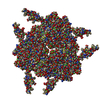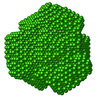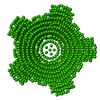+Search query
-Structure paper
| Title | X-Ray Solution Scattering Study of Four Escherichia coli Enzymes Involved in Stationary-Phase Metabolism. |
|---|---|
| Journal, issue, pages | PLoS One, Vol. 11, Issue 5, Page e0156105, Year 2016 |
| Publish date | May 26, 2016 |
 Authors Authors | Liubov A Dadinova / Eleonora V Shtykova / Petr V Konarev / Elena V Rodina / Natalia E Snalina / Natalia N Vorobyeva / Svetlana A Kurilova / Tatyana I Nazarova / Cy M Jeffries / Dmitri I Svergun /   |
| PubMed Abstract | The structural analyses of four metabolic enzymes that maintain and regulate the stationary growth phase of Escherichia coli have been performed primarily drawing on the results obtained from ...The structural analyses of four metabolic enzymes that maintain and regulate the stationary growth phase of Escherichia coli have been performed primarily drawing on the results obtained from solution small angle X-ray scattering (SAXS) and other structural techniques. The proteins are (i) class I fructose-1,6-bisphosphate aldolase (FbaB); (ii) inorganic pyrophosphatase (PPase); (iii) 5-keto-4-deoxyuronate isomerase (KduI); and (iv) glutamate decarboxylase (GadA). The enzyme FbaB, that until now had an unknown structure, is predicted to fold into a TIM-barrel motif that form globular protomers which SAXS experiments show associate into decameric assemblies. In agreement with previously reported crystal structures, PPase forms hexamers in solution that are similar to the previously reported X-ray crystal structure. Both KduI and GadA that are responsible for carbohydrate (pectin) metabolism and acid stress responses, respectively, form polydisperse mixtures consisting of different oligomeric states. Overall the SAXS experiments yield additional insights into shape and organization of these metabolic enzymes and further demonstrate the utility of hybrid methods, i.e., solution SAXS combined with X-ray crystallography, bioinformatics and predictive 3D-structural modeling, as tools to enrich structural studies. The results highlight the structural complexity that the protein components of metabolic networks may adopt which cannot be fully captured using individual structural biology techniques. |
 External links External links |  PLoS One / PLoS One /  PubMed:27227414 / PubMed:27227414 /  PubMed Central PubMed Central |
| Methods | SAS (X-ray synchrotron) |
| Structure data |  SASDB33:  SASDBY2:  SASDBZ2: |
| Source |
|
 Movie
Movie Controller
Controller Structure viewers
Structure viewers About Yorodumi Papers
About Yorodumi Papers




